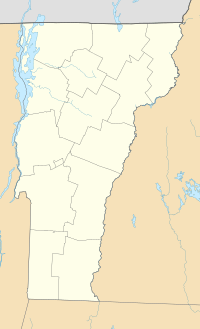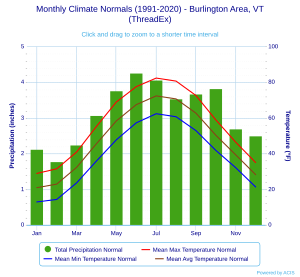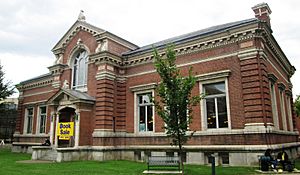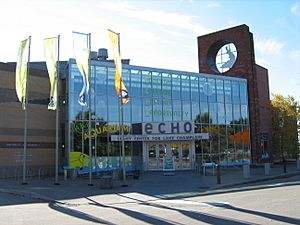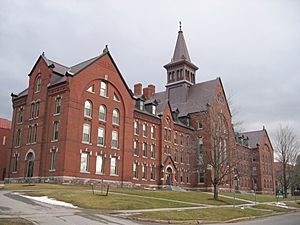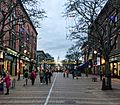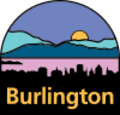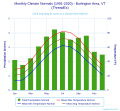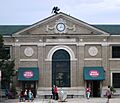Burlington, Vermont facts for kids
Quick facts for kids
Burlington
|
|||||
|---|---|---|---|---|---|
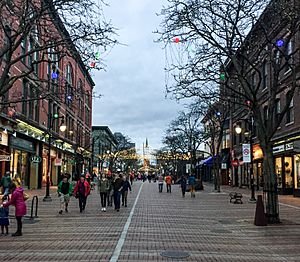
Church Street Marketplace in 2017
|
|||||
|
|||||
| Nicknames:
BTV, The Queen City
|
|||||
| Country | United States | ||||
| U.S. state | Vermont | ||||
| County | Chittenden | ||||
| Region | New England | ||||
| Settled | 1783 | ||||
| Organized (town) | 1785 | ||||
| Incorporated (city) | 1865 | ||||
| Area | |||||
| • City | 15.47 sq mi (40.13 km2) | ||||
| • Land | 10.31 sq mi (26.69 km2) | ||||
| • Water | 5.16 sq mi (13.44 km2) | ||||
| Elevation | 200 ft (61 m) | ||||
| Population
(2020)
|
|||||
| • City | 44,743 | ||||
| • Rank | Vermont: 1st | ||||
| • Density | 4,339.3/sq mi (1,675.4/km2) | ||||
| • Urban | 118,032 (U.S.: 289th) | ||||
| • Urban density | 1,903.3/sq mi (734.9/km2) | ||||
| • Metro | 225,562 (U.S.: 208th) | ||||
| Time zone | UTC−5 (EST) | ||||
| • Summer (DST) | UTC−4 (EDT) | ||||
| ZIP Codes |
05401–05402, 05405–05406, 05408
|
||||
| Area code(s) | 802 | ||||
| FIPS code | 50-10675 | ||||
| GNIS feature ID | 1456663 | ||||
| U.S. Highways | |||||
| State Routes | |||||
Burlington is the largest city in the U.S. state of Vermont. It is the main city of Chittenden County. Burlington is about 45 miles (72 km) south of the Canada–United States border. It is also 95 miles (153 km) south of Montreal.
In 2020, the city had a population of 44,743 people. It is unique because it is the smallest city to be the most populated city in its state.
Burlington is known as a college town. It is home to the University of Vermont (UVM) and Champlain College. The largest hospital in Vermont, the UVM Medical Center, is also in Burlington. The city owns Vermont's biggest airport, the Patrick Leahy Burlington International Airport. This airport is located in nearby South Burlington. In 2015, Burlington became the first city in the U.S. to get all its energy from renewable energy sources.
Contents
History of Burlington
Early Days to the 1900s
There are two ideas about how Burlington got its name. It might have been named after Richard Boyle, the 3rd Earl of Burlington. Another idea is that it was named after the rich Burling family from New York. Even though no Burling family members were officially given land in Burlington, they owned a lot of land in nearby towns. Some of these lands were given out on the same day as Burlington.
The land for Burlington was given out by New Hampshire's governor, Benning Wentworth, in 1763. Settlers started clearing the land and building huts in 1775. But the American Revolutionary War stopped them from settling permanently until after the war ended. The town was officially set up in 1785.
In 1808, the world's first steamboat made for lakes was built in Burlington.
During the War of 1812, about 5,000 U.S. troops were stationed in Burlington. This was more people than the city's residents at the time. About 500 soldiers died from diseases because army camps often had poor sanitation. Some soldiers stayed in the main building at the University of Vermont. A special plaque there remembers them.
On August 2, 1813, British forces from Canada fired cannons at Burlington. This lasted about 10 minutes, but no one was hurt.
Burlington's location on Lake Champlain helped it grow into a busy port. It became a center for trade, especially after canals like the Champlain Canal (1823) and the Erie Canal (1825) were finished. Steamboats connected goods and people with railroads. Burlington became a major center for lumber and manufacturing. For a while, it was the third largest lumber market in the world. It officially became a city in 1865. Many beautiful buildings from the Victorian era still stand today.
In 1870, the waterfront was expanded. Over the years, this area became polluted. In 2009, efforts began to clean it up. When Bernie Sanders became mayor, he started a plan to make the waterfront beautiful. This plan added public parks, a nine-mile bike path, and a community boathouse.
On September 5, 1901, U.S. Vice President Theodore Roosevelt gave a speech in Burlington. Nine days later, he became president after President McKinley died.
Recent History: Late 1900s to Today
In 1978, the famous ice cream company Ben & Jerry's started in Burlington. It began in an old gas station. It grew into a national brand with stores everywhere.
In 2021, the city council discussed a resolution about the conflict between Israel and Palestine. The resolution asked the city council to show support for the Palestinian people. It also asked them to condemn laws against boycotts and support a nonviolent movement called Boycott, Divestment and Sanctions. Some people were concerned about the resolution. The mayor, Miro Weinberger, called it "inappropriate." The council voted to withdraw the resolution.
Geography of Burlington
Burlington is located on the eastern shore of Lake Champlain. It is north of Shelburne Bay. The city is built on a strip of land that stretches about 6 miles (9.7 km) south from the Winooski River. It rises from the lake's edge to a height of about 300 feet (91 m).
In the 1800s, a large valley in what is now downtown Burlington was filled in. This was done to make space for more buildings.
Burlington's Neighborhoods
Burlington has several distinct neighborhoods:
- Downtown is the city's main business area. It is north of Maple Street and west of South Willard Street.
- Hill Section is Burlington's wealthiest neighborhood. It is east of South Union Street and south of Main Street. The Burlington Country Club is located here.
- The Intervale is a large area with many local organic farms and nature areas. It is along the Winooski River. It is bigger than most neighborhoods.
- New North End is the most populated neighborhood. It is a suburban area in the northwest part of the city. It includes Leddy Park, Ethan Allen Park, and North Beach.
- Old North End is Burlington's oldest and most crowded neighborhood. It is north of Downtown. From the 1880s to the 1930s, it was home to a large Jewish community called Little Jerusalem.
- South End used to be an industrial area. Now, it is mostly an artistic district. It is south of Downtown. Many well-known companies like Burton Snowboards have their headquarters here.
- University District is north of the Burlington Country Club. It includes the UVM campus. Many homes here have been turned into apartments for students.
Burlington's Climate
Burlington has a climate with cold winters and humid summers. The average daily temperatures range from 29°F (–1.7°C) in January to 75°F (23.9°C) in July. The city gets about 43 inches (1,092 mm) of rain each year. Rain is spread out evenly, but summers are the wettest.
Sometimes, the city gets heavy snow from snow squalls because it is east of Lake Champlain. These can bring up to 13 inches (33 cm) of snow in 12 hours. On average, Burlington gets 86 inches (218 cm) of snow each year. However, this amount can change a lot from year to year. The most snow from one storm was 33.1 inches (84 cm) in January 2010.
The coldest temperature ever recorded was –30°F (–34°C) in 1957 and 1979. The hottest was 101°F (38°C) in 1944. A heat wave in this area means three days in a row of 90°F (32°C) or higher. There were six such heat waves between 2000 and 2009.
| Climate data for Burlington International Airport, Vermont (1981–2010 normals, extremes 1883–present ) | |||||||||||||
|---|---|---|---|---|---|---|---|---|---|---|---|---|---|
| Month | Jan | Feb | Mar | Apr | May | Jun | Jul | Aug | Sep | Oct | Nov | Dec | Year |
| Record high °F (°C) | 66 (19) |
72 (22) |
84 (29) |
91 (33) |
93 (34) |
100 (38) |
100 (38) |
101 (38) |
98 (37) |
85 (29) |
75 (24) |
68 (20) |
101 (38) |
| Mean maximum °F (°C) | 49.8 (9.9) |
49.3 (9.6) |
63.9 (17.7) |
78.3 (25.7) |
85.2 (29.6) |
90.5 (32.5) |
91.8 (33.2) |
90.1 (32.3) |
85.3 (29.6) |
74.3 (23.5) |
66.0 (18.9) |
52.6 (11.4) |
93.7 (34.3) |
| Mean daily maximum °F (°C) | 27.2 (−2.7) |
30.6 (−0.8) |
40.0 (4.4) |
54.7 (12.6) |
67.2 (19.6) |
76.3 (24.6) |
80.9 (27.2) |
79.0 (26.1) |
70.4 (21.3) |
57.2 (14.0) |
45.5 (7.5) |
33.2 (0.7) |
55.3 (12.9) |
| Daily mean °F (°C) | 18.7 (−7.4) |
21.5 (−5.8) |
31.0 (−0.6) |
44.8 (7.1) |
56.3 (13.5) |
65.8 (18.8) |
70.6 (21.4) |
68.8 (20.4) |
60.5 (15.8) |
48.1 (8.9) |
38.2 (3.4) |
25.8 (−3.4) |
46.0 (7.8) |
| Mean daily minimum °F (°C) | 10.2 (−12.1) |
12.5 (−10.8) |
22.0 (−5.6) |
34.8 (1.6) |
45.4 (7.4) |
55.3 (12.9) |
60.3 (15.7) |
58.5 (14.7) |
50.7 (10.4) |
39.1 (3.9) |
30.9 (−0.6) |
18.5 (−7.5) |
36.6 (2.6) |
| Mean minimum °F (°C) | −13.8 (−25.4) |
−9.4 (−23.0) |
−0.5 (−18.1) |
21.2 (−6.0) |
31.1 (−0.5) |
40.8 (4.9) |
48.8 (9.3) |
45.1 (7.3) |
35.5 (1.9) |
25.0 (−3.9) |
14.0 (−10.0) |
−4.3 (−20.2) |
−16.2 (−26.8) |
| Record low °F (°C) | −30 (−34) |
−30 (−34) |
−24 (−31) |
2 (−17) |
24 (−4) |
33 (1) |
39 (4) |
35 (2) |
25 (−4) |
15 (−9) |
−3 (−19) |
−29 (−34) |
−30 (−34) |
| Average precipitation inches (mm) | 2.06 (52) |
1.76 (45) |
2.22 (56) |
2.82 (72) |
3.45 (88) |
3.69 (94) |
4.16 (106) |
3.91 (99) |
3.64 (92) |
3.60 (91) |
3.13 (80) |
2.38 (60) |
36.82 (935) |
| Average snowfall inches (cm) | 21.1 (54) |
16.4 (42) |
15.8 (40) |
4.6 (12) |
trace | 0 (0) |
0 (0) |
0 (0) |
trace | 0.3 (0.76) |
5.1 (13) |
17.9 (45) |
81.2 (206) |
| Average precipitation days (≥ 0.01 in) | 14.5 | 11.2 | 12.9 | 12.8 | 14.2 | 13.3 | 12.0 | 12.3 | 11.3 | 12.9 | 14.0 | 14.4 | 155.8 |
| Average snowy days (≥ 0.1 in) | 14.5 | 10.7 | 9.0 | 3.1 | 0.1 | 0 | 0 | 0 | 0 | 0.4 | 4.7 | 11.9 | 54.4 |
| Mean monthly sunshine hours | 126.9 | 146.8 | 190.7 | 206.2 | 251.4 | 270.1 | 301.9 | 258.2 | 201.0 | 159.2 | 91.1 | 91.6 | 2,295.1 |
| Percent possible sunshine | 44 | 50 | 52 | 51 | 55 | 58 | 64 | 59 | 53 | 47 | 32 | 33 | 51 |
| Source: NOAA (sun 1961–1990) | |||||||||||||
Population and People
| Historical population | |||
|---|---|---|---|
| Census | Pop. | %± | |
| 1790 | 330 | — | |
| 1800 | 816 | 147.3% | |
| 1810 | 1,690 | 107.1% | |
| 1820 | 2,111 | 24.9% | |
| 1830 | 3,526 | 67.0% | |
| 1840 | 4,271 | 21.1% | |
| 1850 | 7,585 | 77.6% | |
| 1860 | 7,713 | 1.7% | |
| 1870 | 13,596 | 76.3% | |
| 1880 | 11,365 | −16.4% | |
| 1890 | 14,590 | 28.4% | |
| 1900 | 18,640 | 27.8% | |
| 1910 | 20,468 | 9.8% | |
| 1920 | 22,779 | 11.3% | |
| 1930 | 24,789 | 8.8% | |
| 1940 | 27,686 | 11.7% | |
| 1950 | 33,155 | 19.8% | |
| 1960 | 35,531 | 7.2% | |
| 1970 | 38,633 | 8.7% | |
| 1980 | 37,712 | −2.4% | |
| 1990 | 39,127 | 3.8% | |
| 2000 | 38,889 | −0.6% | |
| 2010 | 42,417 | 9.1% | |
| 2020 | 44,743 | 5.5% | |
| U.S. Decennial Census | |||
Who Lives in Burlington?
The 2020 United States census showed that 44,743 people lived in Burlington. Most residents, 85.6%, were White. About 4.4% were Black or African American, and 4.6% were Asian. People of Hispanic or Latino origin made up 3.8% of the population.
There were 17,174 households in the city. On average, there were 2.16 people living in each household.
Income and Housing
From 2017 to 2021, the average household income in Burlington was $59,331. For full-time workers, men earned about $50,552, while women earned about $38,418. The average income per person in the city was $34,054. About 23.8% of the population lived below the poverty threshold.
The average value of homes owned by their residents was $338,100.
Burlington's Economy
Burlington's economy focuses on education, health services, trade, transportation, and some manufacturing. In February 2023, the city's unemployment rate was very low at 2.1%. The average yearly wage in Burlington was $63,180 in 2022.
Businesses and Industries
The biggest employers in Burlington and Vermont are the University of Vermont Medical Center and the University of Vermont. They employ over 8,200 and 4,125 people, respectively.
Other companies in Burlington include Blodgett Ovens, which makes commercial ovens. General Electric develops healthcare software in nearby South Burlington. General Dynamics has a division here that employs 450 workers. Dealer.com, a company for car marketing, employs over 700 people.
Ben & Jerry's started in Burlington in 1978. It is now a global ice cream brand. The Vermont Teddy Bear Company also started in Burlington and now ships teddy bears worldwide.
Companies with their main offices in Burlington include Burton Snowboards, Bruegger's, Lake Champlain Chocolates, Rhino Foods, and Seventh Generation Inc..
Shopping and Tourism
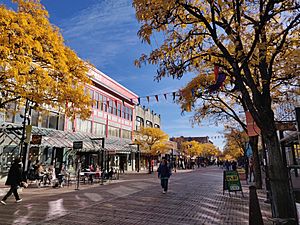
In 2017, Burlington had $591.7 million in retail sales.
The Church Street Marketplace is a four-block pedestrian area in the city center. It hosts festivals all year. Events like the "South End Art Hop" and galleries like Pine Street Art Works show off visual arts in the South End.
The "Festival of Fools" had about 25,000 visitors in 2009. The "Vermont Brewers Festival" had 9,600 visitors that same year. The "Giant Pumpkin Regatta and Festival" had 5,000 visitors. Burlington also has one of the largest year-round farmers' markets in Vermont.
Arts and Culture
Dragon boat races are held in Lake Champlain every August to raise money for charity. In 2009, about 2,000 people on 86 teams took part.
An annual "First Night" celebration of the arts on New Year's Eve started in 1983. It ran for 35 years before ending in 2018.
The city has an art department called Burlington City Arts. It plans cultural events, offers education, shows modern art, and hosts events at The BCA Center. Burlington City Arts also has a program with UVM Medical Center called Art from the Heart. This program gives patients art supplies and time with volunteers.
Local Music Scene
Burlington has supported many local bands over the years. Some have even become national acts. The most famous is Phish, which started at UVM in 1983.
Public Library
The Fletcher Free Library opened in 1873. It was funded by Mary Martha Fletcher, a local businesswoman's daughter. The library quickly outgrew its first building. A new building was built from 1901 to 1904 with money from Andrew Carnegie. This made it the first of four Carnegie libraries in Vermont.
The building had problems in 1973 because it was built over an old railroad valley that wasn't filled in correctly. The library's books had to be moved. Citizens saved the building from being torn down and got it added to the National Register of Historic Places. A grant helped fix and stabilize the building. A new modern part was added in 1981.
The Fletcher Free Library is the largest public library in Vermont. It is also listed on the National Register of Historic Places. In 2002, it had a budget of over $1 million. It lent out more books, had more visitors, and had more computers than any other library in Vermont. Besides being Burlington's public library, it is also a community center. It is a cultural resource for new immigrants and the city's only free public computer center.
Places to Visit
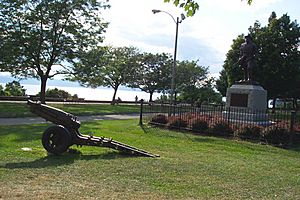
- Ethan Allen Homestead Museum
- Chittenden County Historical Society & Museum
- World's Tallest Filing Cabinet
- ECHO, Leahy Center for Lake Champlain
- Robert Hull Fleming Museum at the University of Vermont
- Flynn Center for the Performing Arts
- Burlington Waterfront Park
- The 1885 building of Ohavi Zedek, one of the oldest synagogue buildings still standing in the United States
Important Buildings and Landmarks
Historic Buildings
Many of Burlington's historic buildings and sites are on the National Register of Historic Places. This list includes 28 buildings, three shipwrecks, the Burlington Breakwater, and 17 historic districts.
Churches and Synagogues
Burlington has many churches, including the North Avenue Alliance Church, First Baptist Church, First Congregational Church, and the Episcopal Cathedral Church of St. Paul. There is also the First United Methodist Church, Christ Church (Presbyterian), and the Roman Catholic Cathedral of St. Joseph. Other places of worship include the First Unitarian Universalist Society, Dormition of the Mother of God Orthodox Church, College Street Congregational Church, The Burlington Church of Christ, and the Church at the Well.
The Conservative Ohavi Zedek synagogue is in the city. There is also an active Meeting of the Religious Society of Friends (Quakers). Other synagogues include Chabad of Vermont, Ahavath Gerim, Ruach HaMaqom, and Ohavi Zedek Chavurah.
The Howard Mortuary Chapel in Lakeview Cemetery was built in 1882. It was a gift to the city from Hannah Louisa Howard, a local helper. The chapel was designed in the High Victorian Gothic style.
The Ira Allen Chapel is on the University of Vermont campus. It was finished in 1926. Its bright light helps people find their way to Burlington from Lake Champlain at night. The chapel is part of the University Green Historic District.
Two of Burlington's cathedrals, the Episcopal Cathedral Church of St. Paul and the former Roman Catholic Cathedral of the Immaculate Conception, are modern buildings. They were built after their old buildings were destroyed by fires in 1971–1972.
Sports in Burlington
| Team | Sport(s) | League | Stadium |
|---|---|---|---|
| Vermont Lake Monsters | Baseball | Futures Collegiate Baseball League | Centennial Field |
| Vermont Catamounts | Various | NCAA Division I | Gutterson Fieldhouse |
| Vermont Green FC | Association Football | USL League Two | Virtue Field |
The Vermont Lake Monsters are a college summer baseball team. They play in the Futures Collegiate Baseball League. They used to be called the Vermont Expos. The team changed its name in 2007. This happened after their main Major League Baseball team moved and changed its name. The Lake Monsters play at Centennial Field on the University of Vermont campus.
Burlington has a rich history in hockey. The first known international ice hockey game happened here in 1886. It was between the Montreal Crystals and employees of a local hotel. The University of Vermont's men's hockey team, the Catamounts, play their home games at the 4,007-seat Gutterson Field House.
The Vermont City Marathon brings thousands of runners each year. A local Golden Gloves boxing tournament has been held every year since 1946.
Burlington was a host city for the 2012 IIHF Women's World Championship in ice hockey.
Education in Burlington
Public Schools
The Burlington School District runs the city's public schools.
Schools:
- Burlington High School
- The Sustainability Academy (at Lawrence Barnes Elementary)
- Edmunds Elementary School
- Edmunds Middle School (used to be Burlington High School)
- Lyman C. Hunt Middle School
- Flynn Elementary School
- Champlain Elementary School
- C. P. Smith Elementary
- The Integrated Arts Academy (at H.O. Wheeler Elementary)
Magnet Schools
Burlington students can choose from two special magnet schools. These are the Integrated Arts Academy at H.O. Wheeler (IAA) and the Sustainability Academy at Lawrence Barnes (SA).
Private Schools
- Christ the King School
- Mater Christi School
- Rock Point School
Colleges and Universities
The University of Vermont (UVM) and Champlain College are located in Burlington. The UVM Medical Center has one of the most selective medical schools in the U.S., the Robert Larner College of Medicine. The Community College of Vermont used to have a campus in Burlington. In 2010, it moved to a new building in nearby Winooski. Saint Michael's College is in the neighboring town of Colchester. Vermont Technical College also has a campus in nearby Williston.
Media in Burlington
Newspapers and Other Publications
Burlington is the media center for northern and central Vermont. It has several publications:
- The Burlington Free Press, a daily newspaper delivered across Vermont.
- Seven Days, a free weekly newspaper focusing on arts and culture. It is available at pickup points in the Burlington area.
- Vermont Business Magazine
- VTDigger
- The Natural Philosopher, a monthly science news journal run by students at the University of Vermont.
Radio Stations
Major radio stations based in Burlington that serve the region include:
- WBTZ (The Buzz) – 99.9 FM (modern rock)
- WCPV (101.3 ESPN) – 101.3 FM (sports)
- WCVT (101 The One) – 101.7 FM (classic album tracks)
- WEZF (Star 92.9) – 92.9 FM (hot adult contemporary)
- WIZN (The Wizard) – 106.7 FM (classic rock)
- WJOY – 1230 AM (adult standards)
- WKOL (KOOL 105) – 105.1 FM (classic hits)
- WNCS and W227AQ (The Point) – 104.7 and 93.3 FM (Triple-A)
- WOKO – 98.9 FM (country music)
- WOXR (Vermont Public Radio) – 90.9 FM (classical)
- WRUV (University of Vermont) – 90.1 FM (variety)
- WTNN (Eagle Country) – 97.5 FM
- WVMT – 620 AM (news/talk)
- WVPS (Vermont Public Radio) – 107.9 FM (news & information), National Public Radio
- WWPV (Saint Michael's College) – 92.5 FM (variety)
- WXXX – 95.5 FM (Hit Music Station)
Television Stations
Five TV stations serve the Burlington area. They include WFFF-TV channel 44 (Fox) and its sister station WVNY channel 22 (ABC). Also, WPTZ channel 5 (NBC) and its sister station WNNE channel 31 (CW). Finally, WCAX-TV channel 3 (CBS). All these stations have news departments. Comcast is the main cable TV provider. However, Burlington residents can also use the city-owned Burlington Telecom.
City Infrastructure
Transportation in Burlington
Bus Services
Burlington is the main hub for Green Mountain Transit (GMT). GMT provides bus service within the city and to nearby towns.
Greyhound offers bus service from the Downtown Transit Center. You can travel to other Vermont towns, Montreal, and Boston. Premier Coach's Vermont Translines also provides bus service between Burlington and Albany, New York.
Train Services
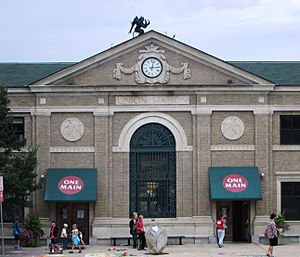
Burlington is connected to New York City by Amtrak's Ethan Allen Express. This train service started in July 2022. Trains arrive at Union Station, which was built in 1916. Before this, the closest Amtrak station was in Essex Junction, Vermont.
Train service began in Burlington in 1849. From the late 1800s until 1953, the Rutland Railroad offered passenger service from Burlington to Troy, New York.
Air Travel
Patrick Leahy Burlington International Airport (BTV) offers commercial flights. These flights go to major regional centers and international airports. The airport has a Customs Port of Entry for flights that are not scheduled.
Main Roads
Burlington is served by one major Interstate highway and its spur route. It is also where two U.S. highways meet. Several Vermont state highways also go into and through the Burlington area.
 Interstate 89: This highway does not go directly into Burlington. However, its exits in nearby South Burlington, Winooski, and Colchester provide access to downtown.
Interstate 89: This highway does not go directly into Burlington. However, its exits in nearby South Burlington, Winooski, and Colchester provide access to downtown. Interstate 189: This road connects I-89 in South Burlington to U.S. 7 at the south end of Burlington.
Interstate 189: This road connects I-89 in South Burlington to U.S. 7 at the south end of Burlington. U.S. Route 2 is the main east-west road into Burlington.
U.S. Route 2 is the main east-west road into Burlington. U.S. Route 7 is the main north-south road through Burlington.
U.S. Route 7 is the main north-south road through Burlington. Vermont Route 127 connects downtown with the New North End and Colchester.
Vermont Route 127 connects downtown with the New North End and Colchester.
Ferry Service
Burlington is the main office for the Lake Champlain Transportation Company. This company offers ferry service across Lake Champlain to New York state. One ferry line runs all year, 24 hours a day, from Grand Isle, Vermont, to Plattsburgh, New York. Another line runs daily from Charlotte, Vermont, to Essex, New York.
Internet and Electricity
The city has its own fiber optic internet service. This provides phone, internet, and television.
Burlington also owns its own power company, Burlington Electric Department. In 2009, the department announced it would buy 40% of the power from a new wind farm.
Renewable Energy Efforts
Burlington started running on 100% renewable energy in 2014. It has been a leader in renewable energy for decades. The Burlington Electric Department began in 1903. It first used coal for power. But after seeing how coal prices changed, the department slowly started using wood as an energy source.
Since then, the city has become very focused on sustainability. Today, it runs entirely on energy from the Winooski One Hydro Plant, wind turbines, and solar panels. It also uses a wood-burning plant at McNeil Generating Station. This made Burlington the first city to run completely on sustainable energy sources.
This change was helped by several mayors and public interest. Mayor Gordon Paquette decided to switch from coal to wood in 1977. Bernie Sanders continued this environmental focus. Peter Clavelle made recycling mandatory and funded energy improvements. In 1995, the city created the Legacy Plan. This plan aimed to create real examples of sustainability.
Today, this plan has succeeded in many ways. Besides keeping energy costs low, sustainability goes beyond energy. A non-profit group in the city started a farm that grows 30,000 pounds of local food. This food helps people who don't have enough to eat. The city has also worked on restoring buildings, adding bike paths, and saving energy downtown.
In September 2019, former mayor Miro Weinberger announced plans for the city to reach net zero by 2030. This means the city would produce and use equal amounts of energy. In October 2020, Burlington Electric suggested a rule to require all buildings to switch to electric energy. This would help the city reach its net-zero goal.
Notable People
Sister Cities
Burlington has several sister cities around the world:
 Arad, Israel
Arad, Israel Bethlehem, Palestine
Bethlehem, Palestine Burlington, Canada
Burlington, Canada Honfleur, France
Honfleur, France Moss Point, Mississippi, United States
Moss Point, Mississippi, United States Nishinomiya, Japan
Nishinomiya, Japan Puerto Cabezas, Nicaragua
Puerto Cabezas, Nicaragua Yaroslavl, Russia (this partnership was paused in 2022)
Yaroslavl, Russia (this partnership was paused in 2022)
Sister Lakes
Burlington also has sister lakes:
 Lake Ohrid, on the border of Albania and North Macedonia
Lake Ohrid, on the border of Albania and North Macedonia Lake Toba, Indonesia
Lake Toba, Indonesia
Images for kids
-
Church Street Marketplace in 2017
-
Church Street Marketplace in autumn
-
Battery Park, overlooking the Burlington Waterfront and Lake Champlain
-
Burlington's Union Station was built in 1916 by the Central Vermont Railway and the Rutland Railroad
See also
 In Spanish: Burlington (Vermont) para niños
In Spanish: Burlington (Vermont) para niños





